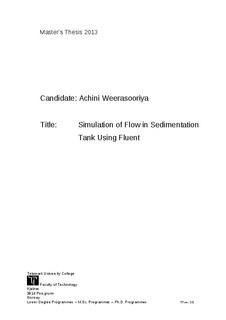| dc.contributor.author | Weerasooriya, Achini | |
| dc.date.accessioned | 2015-10-09T12:55:17Z | |
| dc.date.accessioned | 2017-04-19T13:18:18Z | |
| dc.date.available | 2015-10-09T12:55:17Z | |
| dc.date.available | 2017-04-19T13:18:18Z | |
| dc.date.issued | 2015-10-09 | |
| dc.identifier.citation | Weerasooriya, A. Simulation of flow in sedimentation tank using FLUENT. Master thesis, Telemark University College, 2013 | |
| dc.identifier.uri | http://hdl.handle.net/11250/2439055 | |
| dc.description.abstract | Sewage treatment is the process which removes majority of the contaminants from a sewage stream and produces a liquid effluent suitable for safe disposal into the natural environment and sludge. Physical, chemical and biological processes are carried out in a typical WWTP and the sedimentation process is one of the major physical processes which commonly employed in a WWTP. The sedimentation process at VEAS was studied during this project. VEAS is a large scale sewage treatment plant which serves over 500 000 people in Oslo and Akershus. An effective sedimentation process is important to get the required cleaning level of the effluents and it is very difficult to study or measure the flow fields and velocities inside the sedimentation tanks at VEAS because of the large capacity and the complex geometry. Therefore, a computation study was carried out for one of the sedimentation tanks which is currently operating at VEAS, as a remedy to this problem. Gambit 2.4.6 software was used to generate the geometry and computational mesh of the sedimentation tank and ANSYS FLUENT 13.0 software was used to perform the simulations. Six different cases were studied during this thesis depending on the flow rate and the particle size of the solid phase. Flow fields inside the sedimentation tank was evaluated during CFD simulations and it was observed that the flow currents inside the sedimentation tank are not short circuiting which prevents the mixing of partially settled liquid with unsettled influent. Similar velocity profiles were noticed for both liquid and solid phases. Solid volume fraction profiles for different cases at the outlets of the sedimentation tanks have fluctuating behavior and the highest sedimentation efficiency; 99.88% was observed with the case of 250 μm solid particle diameter with 0.5 m3/h flow rate. Minimum settling efficiency; 1.97% was noticed with the case of 50 μm solid particle diameter with 0.5 m3/h flow rate. Furthermore, any specific trend for the velocity profiles at the outlets of the sedimentation tank couldn?? be observed from the velocity contours and the velocity magnitudes at the inlet weirs are comparatively higher than the velocities near the outlets. Additionally, flow fields inside the tank are not symmetric even though the geometry of sedimentation tank is symmetric except the inlet. | |
| dc.language.iso | eng | |
| dc.publisher | Høgskolen i Telemark | |
| dc.subject | Sewage treatment | |
| dc.subject | Sedimentation | |
| dc.subject | CFD | |
| dc.subject | FLUENT | |
| dc.subject | Flow fields | |
| dc.subject | Sedimentation efficiency | |
| dc.subject | Gambit | |
| dc.title | Simulation of flow in sedimentation tank using FLUENT | |
| dc.type | Master thesis | no |
| dc.description.version | Published version | |
| dc.rights.holder | © Copyright The Author. All rights reserved | |
| dc.subject.nsi | 610 | |
